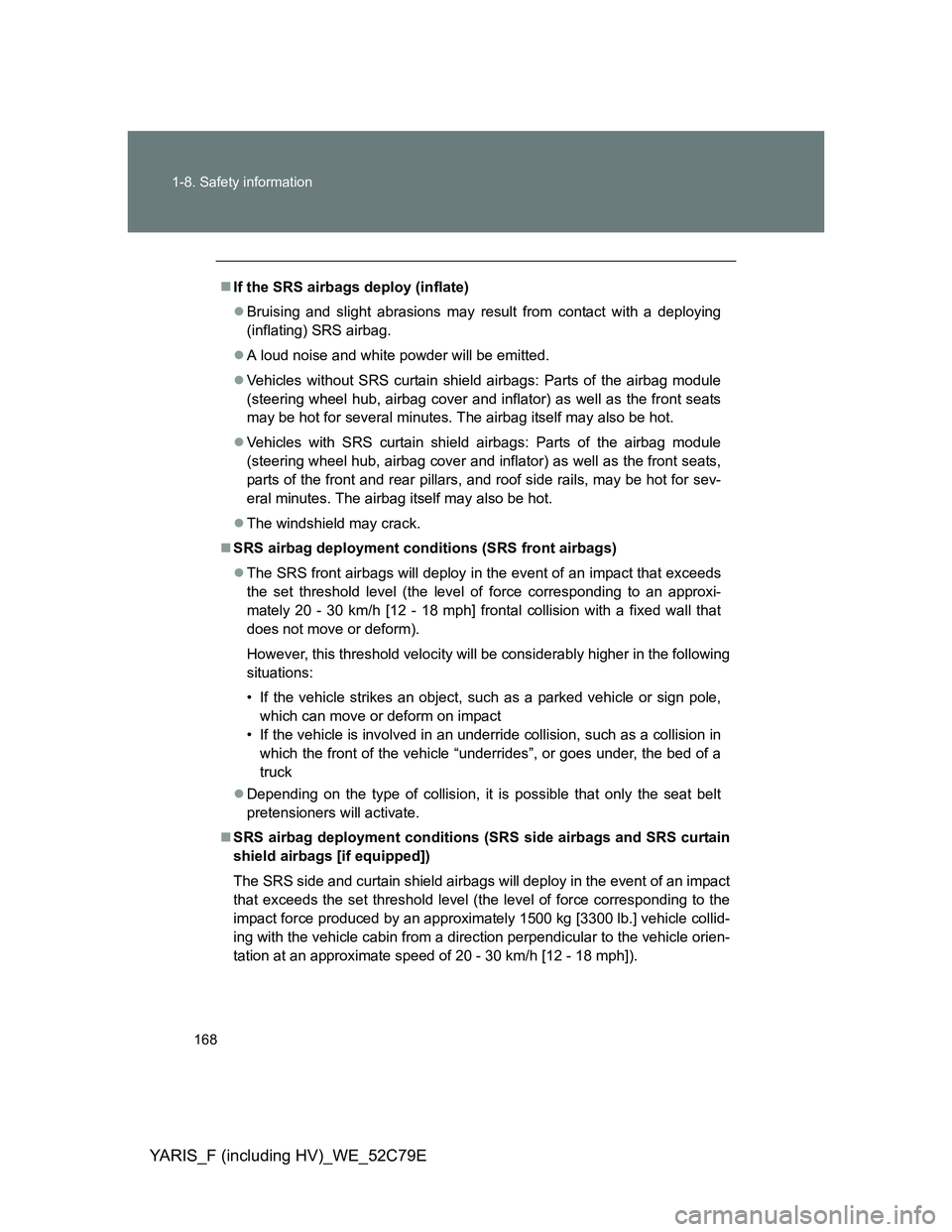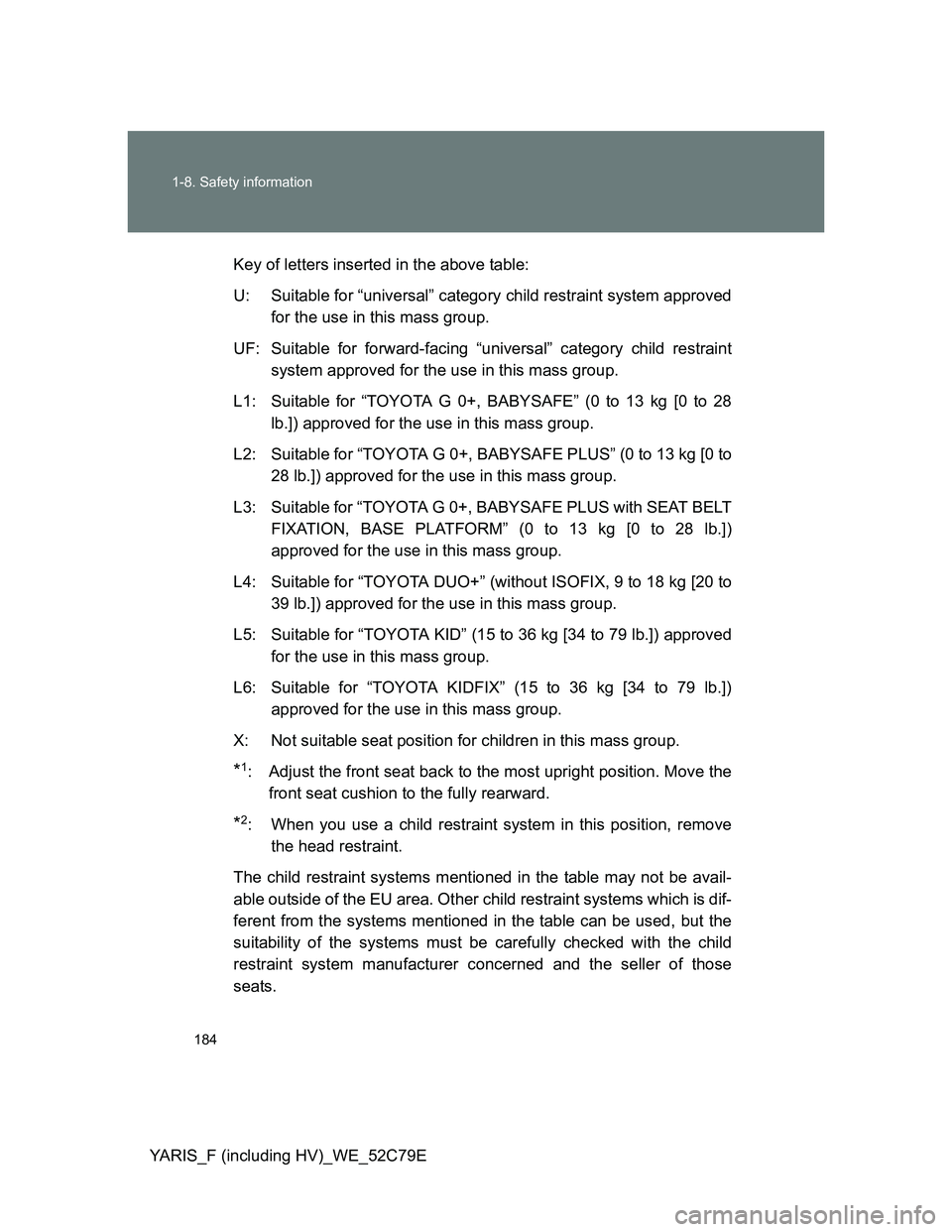Page 166 of 704
166
1-8. Safety information
YARIS_F (including HV)_WE_52C79E
SRS airbags
The SRS airbags inflate when the vehicle is subjected to certain
types of severe impacts that may cause significant injury to the
occupants. They work together with the seat belts to help reduce the
risk of death or serious injury.
SRS front airbags
SRS driver airbag/front passenger airbag
Can help protect the head and chest of the driver and front pas-
senger from impact with interior components
SRS driver knee airbag (if equipped)
Can help provide driver protection
SRS side and curtain shield airbags
SRS side airbags
Can help protect the torso of the front seat occupants
SRS curtain shield airbags (if equipped)
Can help protect primarily the head of occupants in the outer
seats
Page 168 of 704

168 1-8. Safety information
YARIS_F (including HV)_WE_52C79E
If the SRS airbags deploy (inflate)
Bruising and slight abrasions may result from contact with a deploying
(inflating) SRS airbag.
A loud noise and white powder will be emitted.
Vehicles without SRS curtain shield airbags: Parts of the airbag module
(steering wheel hub, airbag cover and inflator) as well as the front seats
may be hot for several minutes. The airbag itself may also be hot.
Vehicles with SRS curtain shield airbags: Parts of the airbag module
(steering wheel hub, airbag cover and inflator) as well as the front seats,
parts of the front and rear pillars, and roof side rails, may be hot for sev-
eral minutes. The airbag itself may also be hot.
The windshield may crack.
SRS airbag deployment conditions (SRS front airbags)
The SRS front airbags will deploy in the event of an impact that exceeds
the set threshold level (the level of force corresponding to an approxi-
mately 20 - 30 km/h [12 - 18 mph] frontal collision with a fixed wall that
does not move or deform).
However, this threshold velocity will be considerably higher in the following
situations:
• If the vehicle strikes an object, such as a parked vehicle or sign pole,
which can move or deform on impact
• If the vehicle is involved in an underride collision, such as a collision in
which the front of the vehicle “underrides”, or goes under, the bed of a
truck
Depending on the type of collision, it is possible that only the seat belt
pretensioners will activate.
SRS airbag deployment conditions (SRS side airbags and SRS curtain
shield airbags [if equipped])
The SRS side and curtain shield airbags will deploy in the event of an impact
that exceeds the set threshold level (the level of force corresponding to the
impact force produced by an approximately 1500 kg [3300 lb.] vehicle collid-
ing with the vehicle cabin from a direction perpendicular to the vehicle orien-
tation at an approximate speed of 20 - 30 km/h [12 - 18 mph]).
Page 171 of 704
171 1-8. Safety information
1
Before driving
YARIS_F (including HV)_WE_52C79E
A portion of a door is damaged or
deformed, or the vehicle was involved
in an accident that was not severe
enough to cause the SRS side airbags
and SRS curtain shield airbags (if
equipped) to inflate.
Vehicles without a SRS driver knee air-
bag: The pad section of the steering
wheel or dashboard near the front pas-
senger airbag is scratched, cracked, or
otherwise damaged.
Vehicles with a SRS driver knee airbag:
The pad section of the steering wheel,
dashboard near the front passenger air-
bag or lower portion of the instrument
panel is scratched, cracked, or other-
wise damaged.
The surface of the seats with the side
airbag is scratched, cracked, or other-
wise damaged.
Vehicles with SRS curtain shield air-
bags: The portion of the front pillars,
rear pillars or roof side rail garnishes
(padding) containing the curtain shield
airbags is inside scratched, cracked, or
otherwise damaged.
Page 173 of 704

173 1-8. Safety information
1
Before driving
YARIS_F (including HV)_WE_52C79E
CAUTION
SRS airbag precautions
Improperly seated and/or restrained infants and children can be killed or
seriously injured by a deploying airbag. An infant or child who is too small
to use a seat belt should be properly secured using a child restraint sys-
tem. Toyota strongly recommends that all infants and children be placed in
the rear seats of the vehicle and properly restrained. The rear seats are
safer for infants and children than the front passenger seat. (P. 181)
Do not sit on the edge of the seat or
lean against the dashboard.
Do not allow a child to stand in front of
the SRS front passenger airbag unit or
sit on the knees of a front passenger.
Do not allow the front seat occupants to
hold items on their knees.
Vehicles without SRS curtain shield air-
bags: Do not lean against the front
door.
Vehicles with SRS curtain shield air-
bags: Do not lean against the door, the
roof side rail or the front, side and rear
pillars.
Page 176 of 704

176 1-8. Safety information
YARIS_F (including HV)_WE_52C79E
CAUTION
SRS airbag precautions
Vehicles with SRS curtain shield airbags: If the areas where the SRS air-
bags are stored, such as the steering wheel pad and front and rear pillar
garnishes, are damaged or cracked, have them replaced by any autho-
rized Toyota dealer or repairer, or another duly qualified and equipped pro-
fessional.
Modification and disposal of SRS airbag system components
Do not dispose of your vehicle or perform any of the following modifications
without consulting any authorized Toyota dealer or repairer, or another duly
qualified and equipped professional. The SRS airbags may malfunction or
deploy (inflate) accidentally, causing death or serious injury.
Installation, removal, disassembly and repair of the SRS airbags
Repairs, modifications, removal or replacement of the steering wheel,
instrument panel, dashboard, seats or seat upholstery, front, side and rear
pillars or roof side rails
Repairs or modifications of the front fender, front bumper, or side of the
occupant compartment
Installation of snow plows, winches, etc. to the front grille (bull bars, or
kangaroo bar etc.)
Modifications to the vehicle’s suspension system
Installation of electronic devices such as an RF-transmitter and CD play-
ers
Page 184 of 704

184 1-8. Safety information
YARIS_F (including HV)_WE_52C79EKey of letters inserted in the above table:
U: Suitable for “universal” category child restraint system approved
for the use in this mass group.
UF: Suitable for forward-facing “universal” category child restraint
system approved for the use in this mass group.
L1: Suitable for “TOYOTA G 0+, BABYSAFE” (0 to 13 kg [0 to 28
lb.]) approved for the use in this mass group.
L2: Suitable for “TOYOTA G 0+, BABYSAFE PLUS” (0 to 13 kg [0 to
28 lb.]) approved for the use in this mass group.
L3: Suitable for “TOYOTA G 0+, BABYSAFE PLUS with SEAT BELT
FIXATION, BASE PLATFORM” (0 to 13 kg [0 to 28 lb.])
approved for the use in this mass group.
L4: Suitable for “TOYOTA DUO+” (without ISOFIX, 9 to 18 kg [20 to
39 lb.]) approved for the use in this mass group.
L5: Suitable for “TOYOTA KID” (15 to 36 kg [34 to 79 lb.]) approved
for the use in this mass group.
L6: Suitable for “TOYOTA KIDFIX” (15 to 36 kg [34 to 79 lb.])
approved for the use in this mass group.
X: Not suitable seat position for children in this mass group.
*1: Adjust the front seat back to the most upright position. Move the
front seat cushion to the fully rearward.
*2: When you use a child restraint system in this position, remove
the head restraint.
The child restraint systems mentioned in the table may not be avail-
able outside of the EU area. Other child restraint systems which is dif-
ferent from the systems mentioned in the table can be used, but the
suitability of the systems must be carefully checked with the child
restraint system manufacturer concerned and the seller of those
seats.
Page 190 of 704
190
1-8. Safety information
YARIS_F (including HV)_WE_52C79E
Installing child restraints
Follow the child restraint system manufacturer’s instructions. Firmly
secure child restraints to the seats using a seat belt or ISOFIX rigid
anchors. Attach the top strap when installing a child restraint.
Seat belts (An ELR belt
requires a locking clip.)
Vehicles with rear seats:
ISOFIX rigid anchors
(ISOFIX child restraint sys-
tem)
Lower anchors are provided for
outside rear seats. (Tags dis-
playing the location of the
anchors are attached to the
seats.)
Vehicles with rear seats:
Anchor brackets (for the top
strap)
Anchor brackets are provided
for outside rear seats.
Page 194 of 704
194 1-8. Safety information
YARIS_F (including HV)_WE_52C79E
Installation with ISOFIX rigid anchors (ISOFIX child restraint
system) (vehicles with rear seats)
Widen the gap between
the seat cushion and
seatback slightly.
Latch the buckles onto
the anchors.
If the child restraint has a
top strap, the top strap
should be latched onto the
anchor bracket.